Papers by Sergio Rodriguez
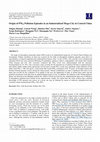
The origin of atmospheric particulate matter (PM) events in an industrialized mega-city of Centra... more The origin of atmospheric particulate matter (PM) events in an industrialized mega-city of Central China (Wuhan) was investigated. Wuhan constitutes an ideal case scenario for the study of atmospheric pollution episodes, given that it is representative of densely populated and industrialized Chinese cities. Levels of PM 10 , NO x and SO 2 were evaluated and automatic PM levels were corrected following EU-guidelines, aiming to achieve comparability with results from outside China (Europe and US). This correction evidenced that PM 10 levels were underestimated with the automatic instrumentation by 26-38%. This correction is thus essential for the potential use of ambient PM data in epidemiological and climate studies within China and abroad. Several types of peak PM 10 events were identified: winter pollution events (daily mean PM 10 = 200-350 µg/m 3 ), Asian desert dust events (PM 10 increments of 60-70 µg/m 3 on the daily means) and biomass burning episodes (scarce during the study period). Natural contributions are thus a significant PM source to be taken into account for the evaluation of air quality in the area, the application of daily or annual limit values and the potential assessment of the data from an epidemiological point of view. In addition, the influence of the Wuhan pollution plume was detected in the Mulanhu regional site, which is 40 km far from the city, underlining the large area of influence of atmospheric pollution from Wuhan on the regional-scale. Finally, the results from this work evidence that a detailed knowledge of PM episodes and sources at a given site may be obtained by means of relatively straightforward and economic routine measurements (PM 10 , NO 2 , SO 2 ).
To study whether the concentrations of particulate matter in ambient air are associated with hosp... more To study whether the concentrations of particulate matter in ambient air are associated with hospital admission due to heart failure in patients with heart failure with preserved ejection fraction and reduced ejection fraction.

ABSTRACT A study on the contribution of vehicle exhausts, ships and an oil refinery emission to t... more ABSTRACT A study on the contribution of vehicle exhausts, ships and an oil refinery emission to the ambient air concentration of ultrafine particles (UFPs) is presented. It is based on a data set of particle number coarser than 2.5 nm (N), black carbon (BC), gaseous pollutants (NOx, SO2, CO and O3), PM2.5 and PM10 measured from 2008 to 2010 in the ambient air of Santa Cruz de Tenerife City, where a previous study found an association between hospitalizations due to heart failure and exposure to UFPs in the ambient air. The observed relationship between N, BC and gaseous pollutants allowed segregating UFP concentrations in a set of components linked to each source. It was found that vehicle exhausts contribute to the background of UFPs, whereas high UFP episodes were due to the emissions of the refinery and ships. The concentration of UFP linked to vehicle exhaust emissions maximized in the morning (07:00–09:00 GMT, 5000–25,000 cm−3=25th–75th percentile), whereas those linked to ship (15,000–45,000 cm−3) and refinery (25,000–95,000 cm−3) emissions maximized in the 10:00–17:00 GMT period due to the effects of meteorology and photochemistry. It was found that the UFP concentrations were more sensitive to the fresh emissions of the three sources than PM2.5, which was mostly linked to aged fine particles (0.1–1 μm) of the urban background. BC was the better tracer of vehicle exhaust emissions. It was concluded that the simultaneous monitoring of UFP, BC and PM2.5 is a suitable strategy of tracing aerosol pollutants of different nature (fresh vs. aged) and from different sources
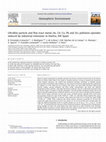
h i g h l i g h t s < We studied how industrial emissions contribute to ultrafine particles (UP).... more h i g h l i g h t s < We studied how industrial emissions contribute to ultrafine particles (UP). < Traffic and industrial UP episodes are identified from the relation of UP and PM 2.5 . < Road traffic emissions, in the morning rush hours, are associated with OM and BC. < Industrial plumes, during daylight, are related with heavy metals. < Industrial emissions are the first cause of high UP in Huelva city. a b s t r a c t Urban air quality impairment by ultrafine particles has become a matter of concern due to the adverse effects on human health. Most of the studies of ultrafine particles in urban air quality have focused on vehicle exhaust emissions. We studied how industrial emissions contribute to ultrafine particle concentrations in downwind urban ambient air. This research is based on experimental data collected in the ambient air of the industrial city of Huelva (SW Spain) over April 2008eDecember 2009 period (particle number, gaseous pollutants and black carbon concentrations and levels and chemical composition of PM 10 and PM 2.5 with daily and hourly resolution). This city is affected by emissions from the second largest Cu-smelter in Europe, phosphoric acid and fertilizer production plants and an oil refinery and petrochemical plant. Industrial emissions are the main cause of ultrafine particle episodes. When vehicle exhaust emissions are the main source, ultrafine particles typically show (24-h mean) concentrations within the range 14,700e5000 cm À3 (50the1st), with 60% of these linked to this source and 30% to industrial emissions. In contrast, when daily mean levels of N are within the range 50,000 e25,500 cm À3 (100the70th), industrial and vehicle exhaust emissions accounted for 49 and 30%, respectively. High concentrations of toxic trace metals (As, Cu, Cd, Zn and Pb) were recorded when the study city suffered fumigations of the Cu-smelter plumes (e.g. 10e25 ng m À3 As, 1e2 ng m À3 Cd and >10 5 cm À3 of ultrafine particles). Because of these industrial emissions, ultrafine particle concentrations during daylight are about two times higher than those observed in other European cities. Recently, ultrafine particle emissions in vehicle exhausts have been subject to limit values in a recent stage of the EURO standards. Industrial emissions should also be considered.
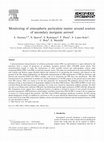
A physicochemical characterisation of airborne particulate matter (PM) was performed in a region ... more A physicochemical characterisation of airborne particulate matter (PM) was performed in a region affected by the emissions from a source of precursors of secondary inorganic aerosols (SIA, 1050 MW power plant). This characterisation sought to study the interferences of other possible natural and anthropogenic sources when monitoring PM10, PM2.5 and PM1 around this emission source. The study was performed in the semi-arid Ebro basin and Catalan and Iberian ranges (Eastern Spain) and consisted in (1) monitoring the transport and impacts on the ground of the SO 2 plume (fumigation), (2) chemically characterising (25 PM components) of TSP-size fractions, and diurnal and nocturnal PM10 and PM2.5 samples, and (3) in measuring the PM mass size distribution. This PM characterisation was undertaken in ambient air, during fumigations of the SO 2 plume on the ground and around other local PM sources. PM1 was found to be the best parameter for monitoring PM pollution derived from the SO 2 emissions owing to the formation of ammonium-sulphate in the finest PM fractions. Three PM1 & PM2.5 events were recorded during the field measurement campaign: two events were caused by ammonium-sulphate episodes, the third was due to an African dust outbreak. PM-mass size distribution and the high correlation of PM1 with SO 2 during the SO 2 fumigation events suggest that a significant fraction of sulphate is formed by means of 'new particle formation' processes (nucleation). PM10 presents a much higher variability (noise) than PM1 & PM2.5 owing to the re-suspension of coarse (2.5-10 mm) mineral dust particles. The PM1 load in PM10 undergoes significant variations: 60-80% during plume fumigations, 20-60% in ambient air, and down to 10% in areas affected by mineral dust re-suspension. The daily cycles observed in some PM components (sulphate, nitrate and mineral dust elements) and the chemical features of PM are also described in detail. r
Temporal series of atmospheric PM1 and PM10 matter (particulate matter with aerodynamic diameter ... more Temporal series of atmospheric PM1 and PM10 matter (particulate matter with aerodynamic diameter below 1 and 10μm) as well as 40K and 7Be concentrations in aerosol filters, collected in the Island of Tenerife from 30 June 2003 until 17 January 2005, were analysed here to: (1) study the variability of 7Be in the atmosphere at this site and (2) to
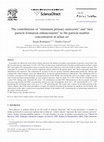
In an urban site affected by fresh vehicle exhaust emissions, the ambient air number concentratio... more In an urban site affected by fresh vehicle exhaust emissions, the ambient air number concentrations of particles coarser than 3 nm (N) was split into two components, N = N1 + N2. This was done using a method based on the high correlation between black-carbon (BC) and number (N) concentrations which is typically observed in ambient air and is the result of vehicle exhaust emissions. The component N1 accounts for "those aerosol components directly emitted in the particle phase" and "those components nucleating immediately after emission". The component N2 accounts for the new particle formation enhancements during the "dilution and cooling of the vehicle exhaust" and is also influenced by "in situ new particle formation in ambient air". The contribution of N1 to N exhibits a maximum of 55% during the morning rush hours (07:00-08:00). The contribution of N2 to N exhibits a daily evolution with a broad maximum during daylight (as solar radiation intensity), while for about 7 h (11:00-17:00) the N2 contribution to N is about 70%. During some "afternoon N2 events", N2 contributions exceeded 90%. Enhancements in the new particle formation processes may increase the N/BC concentrations ratio in one order of magnitude, from 4.82 × 10 6 particles/ng BC to 47 × 10 6 particles/ng BC and during some events up to 97 × 10 6 particles/ng BC. The results show evidence of the high potential of the vehicle exhausts and of the urban atmosphere to trigger new particle formation if the ambient air conditions are favourable. The method used in this study is useful in assessing future changes in the number to BC relationship due to forthcoming regulations in the vehicle exhaust emissions. ᭧
En México es común la utilización del rastrojo de maíz como alimento para rumiantes, pese a que p... more En México es común la utilización del rastrojo de maíz como alimento para rumiantes, pese a que posee poco valor alimenticio, baja digestibilidad y es muy tosco debido a su estado de lignificación. El interés por la utilización de residuos agrícolas en la alimentación de rumiantes se ha venido incrementando en el ámbito AGRONOMÍA MESOAMERICANA 12(2): 189-192. 2001
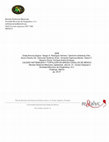
En México, como en gran parte de Centro y Sudamérica, el maíz (Zea mayz L.) es utilizado principa... more En México, como en gran parte de Centro y Sudamérica, el maíz (Zea mayz L.) es utilizado principalmente para consumo humano, pues con él se elaboran diferentes alimentos, como las tortillas. El grano que va ser nixtamalizados para la elaboración de tortillas debe producir masa con alta humedad, buena extensibilidad y resistencia al corte de las tortillas. En esta investigación se evaluaron cinco tipos raciales de maíces criollos para elaborar tortillas, excepto la raza Dulce. De cada raza de maíz se determinaron las propiedades físicas del grano, masa y tortillas; en grano se determinó: dureza, tamaño, humedad, peso hectólitrico, perfil amilográfico y color; en la masa: adhesividad, cohesión y humedad; en las tortillas: tensión, corte, color y humedad. Se encontró que el largo del grano osciló de 11.97 a 18.57 mm, valores que corresponden al maíz Dulce y Pepitilla, respectivamente. La dureza del grano fluctuó entre 11.46 (Tuxpeño) y 4.71 kg (Pátzcuaro 2). La viscosidad máxima de la harina del grano de los maíces evaluados osciló entre 357 y 1813 cp. En el peso por hectolitro, Jala y Tuxpeño cumplen con los requerimientos mínimos establecidos en la norma de calidad (74 kg hL -1 ) para maíces destinados al proceso de nixtamalización. La humedad del grano, masa y tortilla fluctuaron entre 10.0-11.6 %, 54.2-58.0 % y 42.30-44.28 %, respectivamente. En textura de tortilla, el maíz Tuxpeño fue el que presentó la menor resistencia a la tensión y al corte, y el que produjo la mejor tortilla elaborada.

Brazilian Journal of Veterinary Research and Animal Science, 2003
As lesões glaucomatosas são progressivas e irreversíveis. Estudos sobre o aparecimento e comporta... more As lesões glaucomatosas são progressivas e irreversíveis. Estudos sobre o aparecimento e comportamento desta enfermidade vêm sendo discutidos na oftalmologia em geral. O diagnóstico precoce é de extrema importância para o tratamento e estabilização da mesma. A análise da espessura da camada de fibras nervosas retinianas ''in vivo'' foi proposta na oftalmologia humana, para estabelecer as alterações produzidas pelo glaucoma, e tem demonstrado que tais alterações podem ser detectadas até seis anos antes de alterações de campo visual e aumento de pressão intraocular. Entretanto, na Medicina Veterinária, estes dados carecem de estudo e discussão. Neste experimento foram utilizados dois grupos de cães, com olhos normais e olhos glaucomatosos, que foram submetidos à análise das fibras nervosas retinianas através do Analisador de Fibras Nervosas GDx. Os resultados estatísticos demonstraram que a camada de fibras nervosas dos olhos dos cães glaucomatosos estava mais delgada (p < 0,05) quando comparados aos olhos de cães normais, confirmando a perda de axônios das células ganglionares em olhos de cães com glaucoma.
Separation of epistatic, additive and dominant effects on corn. The inheritance of host to stunt ... more Separation of epistatic, additive and dominant effects on corn. The inheritance of host to stunt maize was studied under natural field conditions. Inbred lines P 1 (moderately resistant) and P 2 (susceptible) and their F 1 , F 2 , (BC(P 1 ) and BC(P 2 )) progenies were evaluated at two seasons at sea level, in Veracruz in 1999.
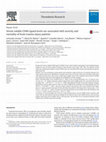
Thrombosis research, 2014
Background: Serum soluble CD40 Ligand (sCD40L) levels, which exhibit prothrombotic and proinflamm... more Background: Serum soluble CD40 Ligand (sCD40L) levels, which exhibit prothrombotic and proinflammatory properties, have not been studied in patients with traumatic brain injury (TBI). Thus, the objective of this study was to determine whether serum sCD40L levels are associated with severity and mortality in patients with severe TBI. Methods: This was a prospective, observational and multicenter study carried out in six Spanish Intensive Care Units. Patients with severe TBI defined as Glasgow Coma Scale (GCS) lower than 9 were included, while those with Injury Severity Score (ISS) in non-cranial aspects higher than 9 were excluded. Serum levels of sCD40L were measured on the day of TBI. Endpoint was established in 30-day mortality. Results: We found higher serum sCD40L levels (P b 0.001) in non-surviving TBI patients (N = 27) than in survivor ones (N = 73). Logistic regression analysis showed that serum sCD40L levels were associated with 30-day mortality (OR = 1.58; 95% CI = 1.12-2.21; P = 0.008) controlling for APACHE-II score and computer tomography findings. The area under the curve (AUC) for serum sCD40L levels as predictor of 30-day mortality was 0.79 (95% CI = 0.70-0.86; P b 0.001). Survival analysis showed that patients with serum sCD40L levels higher than 2.11 ng/mL presented increased 30-day mortality than patients with lower levels (Hazard ratio = 9.0; 95% CI = 4.25-19.27; P b 0.001). We found an association between serum sCD40L levels and APACHE-II (rho = 0.33; P = 0.001), and GCS score (rho = -0.21; P = 0.04). Conclusions: To our knowledge, this is the first study reporting data on serum sCD40L levels in patients with severe TBI. The most relevant and newer findings of our study are that serum sCD40L levels in non-surviving patients with severe TBI are higher than in surviving ones, and that there are an association between serum sCD40L levels and TBI severity and mortality.

Chemosphere, 2015
A detailed spatial and temporal assessment of urban NH3 levels and potential emission sources was... more A detailed spatial and temporal assessment of urban NH3 levels and potential emission sources was made with passive samplers in six major Spanish cities (Barcelona, Madrid, A Coruña, Huelva, Santa Cruz de Tenerife and Valencia). Measurements were conducted during two different periods (winter-autumn and spring-summer) in each city. Barcelona showed the clearest spatial pattern, with the highest concentrations in the old city centre, an area characterised by a high population density and a dense urban architecture. The variability in NH3 concentrations did not follow a common seasonal pattern across the different cities. The relationship of urban NH3 with SO2 and NOX allowed concluding on the causes responsible for the variations in NH3 levels between measurement periods observed in Barcelona, Huelva and Madrid. However, the factors governing the variations in A Coruña, Valencia and Santa Cruz de Tenerife are still not fully understood. This study identified a broad variability in NH3 concentrations at the city-scale, and it confirms that NH3 sources in Spanish urban environments are vehicular traffic, biological sources (e.g. garbage containers), wastewater treatment plants, solid waste treatment plants and industry. The importance of NH3 monitoring in urban environments relies on its role as a precursor of secondary inorganic species and therefore PMX. Further research should be addressed in order to establish criteria to develop and implement mitigation strategies for cities, and to include urban NH3 sources in the emission inventories.
Atmospheric …, 2011
In many large cities of Europe standard air quality limit values of particulate matter (PM) are e... more In many large cities of Europe standard air quality limit values of particulate matter (PM) are exceeded. Emissions from road traffic and biomass burning are frequently reported to be the major causes. As a consequence of these exceedances a large number of air quality plans, most of them focusing on traffic emissions reductions, have been implemented in the last decade. In spite of this implementation, a number of cities did not record a decrease of PM levels. Thus, is the efficiency of air quality plans overestimated? Do the road traffic emissions contribute less than expected to ambient air PM levels in urban areas? Or do we need a more specific metric to evaluate the impact of the above emissions on the levels of urban aerosols?
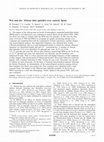
Journal of Geophysical …, 2005
1] The impact of the African dust on levels of atmospheric suspended particulate matter (SPM) and... more 1] The impact of the African dust on levels of atmospheric suspended particulate matter (SPM) and on wet deposition was evaluated in eastern Iberia for the period 1996-2002. An effort was made to compile both the SPM and wet episodes. To this end, the time series of levels of TSP and PM10 in Levantine air quality monitoring stations were evaluated and complemented with the computation of back trajectories, satellite images, and meteorological analysis. Wet deposition frequency was obtained from weekly collected precipitation data at a rural background station in which the African chemical signature was identified (mainly pH and Ca 2+ concentrations). A number of African dust episodes (112) were identified (16 episodes per year). In 93 out of the 112 (13 episodes per year) the African dust influence caused high SPM levels. In 49 out of 112 (7 episodes per year), wet deposition was detected, and the chemistry was influenced by dust. There is a clear seasonal trend with higher frequency of dust outbreaks in May-August, with second modes in March and October. Wet events followed a different pattern, with a marked maximum in May. Except for one event, December was devoid of African air mass intrusions. On the basis of seasonal meteorological patterns affecting the Iberian Peninsula, an interpretation of the meteorological scenarios causing African dust transport over Iberia was carried out. Four scenarios were identified with a clear seasonal trend. The impact of the different dust outbreak scenarios on the levels of PM10 recorded at a rural site (Monagrega, Teruel, Spain) in the period 1996-2002 was also evaluated. Citation: Escudero, M., S. Castillo, X. Querol, A. Avila, M. Alarcón, M. M. Viana, A. Alastuey, E. Cuevas, and S. Rodríguez (2005), Wet and dry African dust episodes over eastern Spain,
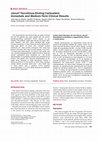
Revista Espanola De Cardiologia, 2007
This observational and clinical follow-up study involved the first 50 patients who were treated w... more This observational and clinical follow-up study involved the first 50 patients who were treated with the Janus ® tacrolimus-eluting carbostent (Sorin Group) at our hospital. The patients' mean age was 66 (10) years, 38% were diabetic, and 56% were admitted with acute coronary syndrome. In total, 56 lesions were treated (52% were type B2/C), of which 12% involved in-stent restenosis, 5% were chronic occlusions, 23% were long lesions (>20 mm), 25% were in small vessels (Յ2.5 mm), 7% were aorto-ostial lesions, 5% were in vein grafts, and 14% involved angiographically visible thrombus. Some 63 Janus ® carbostents were implanted (ie, 1.26 [0.49] stents/patient). A successful outcome was achieved for all lesions. One patient (2%) required reintervention at the target lesion because of acute thrombosis. During a follow-up period of 10 (3) months, 8 (16%) major adverse cardiac events occurred: there was 1 (2%) death due to heart failure and 7 patients (14%) required revascularization, in 5 (10%) cases because of restenosis of the Janus ® carbostent.
American Journal of Obstetrics and Gynecology, 2006
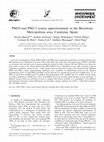
Atmospheric …, 2001
Levels of total suspended particles, PM10, PM2.5 and PM1 were continuously monitored at an urban ... more Levels of total suspended particles, PM10, PM2.5 and PM1 were continuously monitored at an urban kerbside in the Metropolitan area of Barcelona from June 1999 to June 2000. The results show that hourly levels of PM2.5 and PM1 are consistent with the daily cycle of gaseous pollutants emitted by traffic, whereas TSP and PM10 do not follow the same trend, at least in the diurnal period. The PM2.5/PM10 ratio is dependent on the traffic emissions, whereas additional contribution sources for the >10 mm fraction must be taken into account in the diurnal period. Different PM10 and PM2.5 source apportionment techniques were compared. A methodology based on the chemical determination of 83% of both PM10 and PM2.5 masses allowed us to quantify the marine (4% in PM10 and o1% in PM2.5), crustal (26% in PM10 and 8% in PM2.5) and anthropogenic (54% in PM10 and 73% in PM2.5) loads. Peaks of crustal contribution to PM10 (up to 44% of the PM10 mass) were recorded under Saharan air mass intrusions. A different seasonal trend was observed for levels of sulphate and nitrate, probably as a consequence of the different thermodynamic behaviour of these PM species and the higher summer oxidation rate of SO 2 . r




Uploads
Papers by Sergio Rodriguez